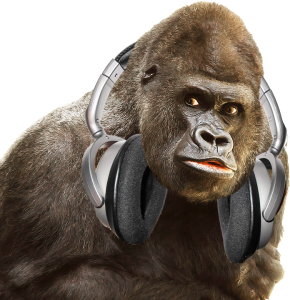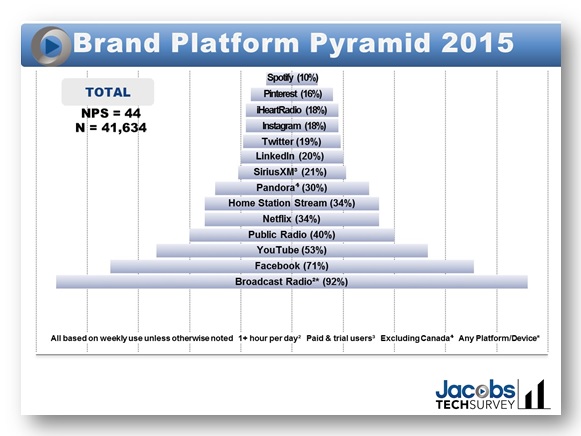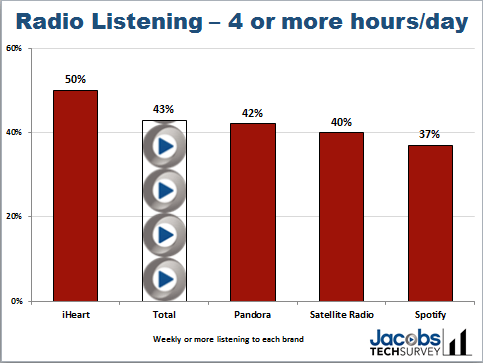There’s a belief in some radio circles that once listeners get a taste of Pandora, SiriusXM, or other tasty new media music offerings, it’s over.
But it’s not.
It turns out that while core radio listeners may be enjoying all sorts of new media outlets, from social to video to web news to music pure-plays, it doesn’t necessarily put a damper on their continued enthusiasm for and use of broadcast radio.
For our Techsurvey11 earlier this year, we created a Brand Platform Pyramid that highlighted some of the specific new media brands that radio listeners use:
It is truly amazing to see that over half the core radio listening audience spends time on YouTube during the course of a week. Three in ten visit Pandora during an average 7-day period. And more than seven in ten log onto Facebook at least weekly (if not more often). These are brands that have truly made an impact on many consumers.
So what does the impact of these new choices have on a legacy medium like radio?
Last week, SiriusXM’s EVP & CFO, David Frear, spoke at a Bank of America meeting about satellite radio and its relationship with broadcast radio. Here are his comments, courtesy of Tom Taylor’s NOW:
“So terrestrial to me looks like a very healthy business. [But] to you guys, it probably doesn’t look that way, because there is leverage that a couple of [the radio companies] have. They’re not great equity stories, with no real growth at the topline. But (radio) is overwhelmingly where people who leave our service go.”
Frear also noted that when consumers tune out satellite radio, they “aren’t going to the streaming players, they’re going back to listen to AM/FM radio…They’re the 800-pound gorilla.”
In this year’s Techsurvey, we put that to the test. We looked at daily radio listening across our entire 41,000+ sample. And then we drilled down to study consumers who are regular listeners of Pandora, Spotify, or the aforementioned Sirius XM. Just because they use these new media services, does their overall radio listening fall below the average as a result?
The chart below tells a fascinating story. Overall, more than four in ten respondents in the total sample spend four or more hours listening to radio on an average day:
The iHeart Radio team will be happy to know their regular users are even heavier radio listeners. But for Pandora and SiriusXM consumers, their level of overall radio listening closely matches the average. Only Spotify users fall considerably below the norm.
But the question is whether those who spend time on new media outlets are still enthusiastic about their favorite radio stations. Once you discover Pandora, SiriusXM, and Spotify, do you still actively extol the virtues of AM/FM radio to friends, family members, and co-workers?
To make that determination, we use a scoring system called Net Promoter. It’s a recommendation metric that illustrates the degree to which consumers are willing to tell others about a product or service – in this case, the radio station they listen to in order to participate in our Techsurveys.
For the mega-sample, the Net Promoter Score averages out to 44. And as you can see on the chart below – and we looked at this in many different ways – regular users of Facebook, YouTube, Pandora, and many other popular digital brands give their primary radio stations consistently solid recommendation scores.
Ironically, SiriusXM fans give their favorite broadcast radio stations the lowest score, but it’s still solid and it compares well to these other digital brands. Across the board, it is clear that what David Frear is saying rings true. Just because a consumer has gravitated to new media outlets doesn’t necessarily erode their positive feelings about the radio stations they listen to most. In many cases, it doesn’t change.
That’s a key takeaway from our Techsurvey. And it’s a reminder to programmers, managers, and personalities that a focus on making their broadcast radio stations competitive, entertaining, informative, relevant, and compelling is of even more paramount importance in a very busy media environment.
No one can control what today’s new media darlings will do or how they will perform. But radio programmers can still produce the best experience possible.
And the other advantage continues to be obvious, as seen through the eyes of AM/FM’s key competitors:
Radio is still the 800 pound gorilla.
How do your listeners spend their media time when they’re not tuned in to your station? Become a stakeholder in Techsurvey12 and find out how to develop an optimal digital strategy. Information and registration are here.
- Why “Dance With Those Who Brung You” Should Be Radio’s Operating Philosophy In 2025 - April 29, 2025
- The Exponential Value of Nurturing Radio Superfans - April 28, 2025
- What To Do If Your Radio Station Goes Through A Midlife Crisis - April 25, 2025








I have permanently left commercial terrestrial radio pretty much forever.
I have worked in radio for more than 40 years.
The best days of commercial radio are behind us.
National and regional program directors working for 1 major radio company, be it Cumulus Media or Clear Channel Communications, programming for the entire country, have no imagination or creativity.
It is now a juke box spitting out the latest non imaginative music being played back on hard drives, servers, with board ops that have no voice, no imagination.
Leo, I appreciate your views, but not all radio is top down, unimaginative, and banal. The medium is still powerful as SiriusXM’s Frear notes. Thanks for the opinion and for reading our blog.
Fred, Paul and the team at Jacobs Media, Thank you very much for conducting the research & publishing this information. This data you present once again shows that the perception of alternative audio services is so much bigger than the reality. We need information like this to show our advertisers that radio remains amazingly monstrous and effective! Thanks again!
John Beck, Emmis Radio St. Louis
John, great to hear from you and thanks for the kind words.